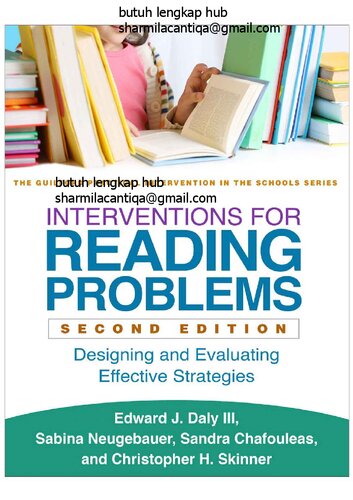

Most ebook files are in PDF format, so you can easily read them using various software such as Foxit Reader or directly on the Google Chrome browser.
Some ebook files are released by publishers in other formats such as .awz, .mobi, .epub, .fb2, etc. You may need to install specific software to read these formats on mobile/PC, such as Calibre.
Please read the tutorial at this link. https://ebooknice.com/page/post?id=faq
We offer FREE conversion to the popular formats you request; however, this may take some time. Therefore, right after payment, please email us, and we will try to provide the service as quickly as possible.
For some exceptional file formats or broken links (if any), please refrain from opening any disputes. Instead, email us first, and we will try to assist within a maximum of 6 hours.
EbookNice Team

Status:
Available4.6
41 reviews(Ebook) Interventions for Reading Problems Designing and Evaluating Effective Strategies 2nd Edtion by Edward J Daly, Sabina Neugebauer, Sandra M Chafouleas, Christopher H Skinner - Ebook PDF Instant Download/Delivery: 9781462519279 ,146251927X
Full download (Ebook) Interventions for Reading Problems Designing and Evaluating Effective Strategies 2nd Edtion after payment

Product details:
ISBN 10: 146251927X
ISBN 13: 9781462519279
Author: Edward J Daly, Sabina Neugebauer, Sandra M Chafouleas, Christopher H Skinner
(Ebook) Interventions for Reading Problems Designing and Evaluating Effective Strategies 2nd Edtion Table of contents:
1. Introduction and Overview
Characteristics of the Approach Taken in This Book
A Brief Overview of the Second Edition
2. Where Do You Start as a Consultant?
Reading Targets across the Continuum of Reading Proficiency
Qualities and Characteristics of Effective Reading Instruction
The Instructional Hierarchy
Prerequisite Skills
Teaching Materials and Difficulty Levels
Other Qualities of Teaching Materials
Summarizing with an Example
Sufficient Time for Learning and Meaningful Active Engagement
Responsive Instruction
Identifying the Entry Point for Intervention Efforts
Too Much Effort for Too Little Yield
Unsound Instructional Environment
Conflicting Organizational Priorities
Unwillingness to Cooperate
The Right Questions Are Not Being Asked
Internet Resources
Aimsweb
Dynamic Indicators of Basic Early Literacy Skills (DIBELS)
Headsprout
Intervention Central
National Center on Intensive Intervention (NCII)
National Center on Progress Monitoring
National Reading Panel
3. Multi-Tiered Reading Interventions
The Origins of Response to Intervention as a Multi-Tiered Intervention Model
How Multi-Tiered Interventions Are Structured in Response to Intervention
Evaluating and Selecting a Strong Core Curriculum
Looking for Research-Based Curricula
Using Screening Data to Evaluate Your Core Reading Curriculum
Common Problems with Core Curricula
Making Adjustments within Tiers
Conclusions
4. Diverse Learners
Who Are English Learners?
Evidence-Based Guidelines and Practices for English Learners
Formative Assessment
Small-Group Interventions
Heterogeneous Ability Groupings
High-Quality Vocabulary Instruction
Academic Language and the Use of Supplementary Materials
How to Appropriately Assess English Learners
Determining Areas for Growth
Conclusions
5. Early Literacy
What Is Early Literacy?
Definition
Phonological Awareness and Phonemic Awareness
Letter Sounds and the Alphabetic Principle
Phonics
Why Is It Difficult for Some Students to Establish Proficient Early Literacy Skills?
Recommendations for Early Literacy Instruction in a Multi-Tiered Framework
Key Features of Good Content Instruction (What to Teach) in Early Literacy
Key Features of Good Delivery of Instruction (How to Teach) in Early Literacy
Case Example
Selecting an Intervention Based on Assessment Data
Instructional Program Examples
Case Example Revisited
Conclusions
APPENDIX 5.1. Additional Early Literacy Intervention Package Resources
Whole-Class Instruction
Small-Group Instruction
Computer Software
6. Producing Measurable Increases in Reading Fluency
Why Is Fluency Important?
Fluent Readers Are More Likely to Comprehend
Fluent Readers Are More Likely to Choose to Read
Fluent Reading Is Less Effortful
Fluency-Induced Spirals
Assessing Reading Fluency Using Curriculum-Based Measurement
Curriculum-Based Measurement Oral Reading Fluency Assessment Materials
Empirically Validated Reading Interventions
Repeated Readings
Phrase Drill Error Correction
Performance Feedback
Modeling: Listening While Reading
Teaching Words in Isolation
The Context for Reading Intervention: Putting the Components Together
Prioritizing Intervention Strategies
When You Can’t Go Lower in the Curricular Basal Series
Classwide Peer Tutoring
Conclusions
7. Vocabulary
Why Is It Important to Teach Vocabulary?
Instructional Strategies for Increasing Vocabulary
Strategies for All Students as Word Learners
Strategies for Young Word Learners
Strategies for Older Word Learners
Putting It All Together
Assessing Vocabulary Knowledge
The What and How of Sensitive Vocabulary Assessments
What Standardized Norm-Referenced Vocabulary Assessments Can Tell You
Intensifying Vocabulary Instruction in a Multi-Tiered Framework
Modeling
Scaffolding
Feedback
Intensifying Vocabulary Instruction for English Learners
Conclusions
8. Reading Comprehension
What Is Reading Comprehension?
Reading Activities Appropriate for the Reader
Prereading or Previewing Comprehension Activities
Comprehension Activities and Strategies during Reading
Postreading Comprehension Activities
Combining Procedures
Text Choices
What Texts Should Teachers Choose?
What Are Appropriate Self-Selected Books?
Reinforcing Reading Comprehension
Intervening with Feedback and Reinforcement
Intensifying and Pacing Instruction
Assessment
Oral Retell Measures of Comprehension
Examiner-Written Comprehension Questions
Rate of Comprehension
Cautious Decision Making Based on Comprehension Assessment
Conclusions
9. Accountability: Are You Making a Measurable Difference?
The Measure of Professional Performance
The Importance of Accountable Practice
Overcoming Sources of Professional Error in Practice
The Need for Local Validation of Outcomes for Professional Services
It Starts with the Individual
The Changing Context for Meeting the Needs of Students with Reading Problems
Rounding Out Your Reading Intervention-Based Services with an Accountability Component
An Explicit Model of Service Delivery
An Explicit Model of Accountability
Data Summarization Methods
Pulling the Data Together and Reporting Results
Gauging Your Outcomes: Establishing a Basis for Comparison
Sharing Your Results with Others
Wrapping Up
References
Index
People also search for (Ebook) Interventions for Reading Problems Designing and Evaluating Effective Strategies 2nd Edtion:
reading interventions for phonemic awareness
quick reading interventions
intervention plan for students with reading difficulties
reading interventions for upper elementary students
vocabulary reading interventions
Tags: Edward J Daly, Sabina Neugebauer, Sandra M Chafouleas, Christopher H Skinner, Reading Problems, Effective Strategies